Diffusion MRI: Acquisition & Artifact Correction
Oral
Diffusion
Thursday, 21 June 2018
| N02 |
15:30 - 17:30 |
Moderators: Hua Guo, Trong-Kha Truong |
15:30
 |
1201.
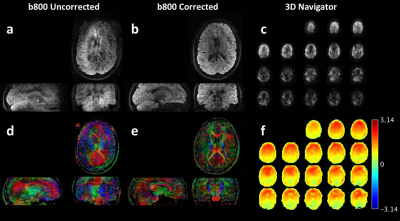 |
 3D Diffusion Imaging with SPiral Encoded Navigators from Stimulated Echoes (3D DISPENSE) 3D Diffusion Imaging with SPiral Encoded Navigators from Stimulated Echoes (3D DISPENSE)
Qinwei Zhang, Bram Coolen, Aart Nederveen, Gustav Strijkers
In this work, we present a new method for motion-insensitive 3D multi-shot diffusion imaging, by using 3D Diffusion Imaging with SPiral Encoded Navigators from Stimulated Echoes (3D DISPENSE). The 3D spiral navigator is acquired with a single readout and generated between diffusion preparation and image acquisition from the twin-pathway of the stimulated echo TSE imaging signal pathway. Therefore, the proposed 3D navigator technique does not compromise diffusion weighting or TSE readout efficiency. We demonstrated the feasibility of this method in phantoms, as well as by in vivo 3D high resolution artifact-free diffusion tensor imaging with nearly full brain coverage.
|
15:42
 |
1202.
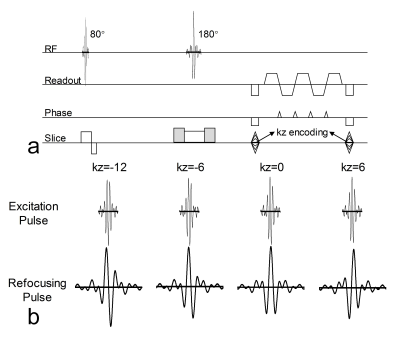 |
 A 3D k-Space Fourier Encoding and Reconstruction Framework for Simultaneous Multi-Slab Acquisition A 3D k-Space Fourier Encoding and Reconstruction Framework for Simultaneous Multi-Slab Acquisition
Erpeng Dai, Yu-hsuan Wu, Hua Guo
3D multi-slab acquisition is an important technique for high-resolution isotropic diffusion imaging. To further accelerate the acquisition, simultaneous multi-slice (SMS) excitation can be combined with multi-slab. Although either multi-slab or SMS acquisition can be described using a 3D k-space, it’s hard to describe simultaneous multi-slab (SMSlab) using a 3D k-space. In this study, it’s shown that by using RF modulation and gradient encoding together, SMSlab acquisition can also be described by a 3D k-space. It’s further demonstrated that parallel imaging techniques, such as 2D SENSE and 2D GRAPPA, can be used to recover the under-sampled k-space from SMSlab.
|
15:54
|
1203.
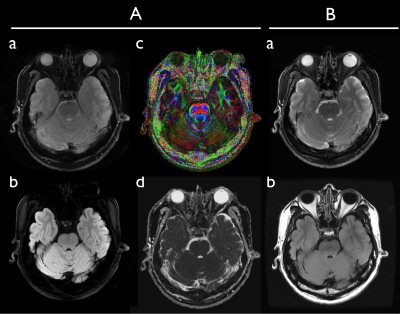 |
 Distortion-Free, High-Resolution Diffusion Imaging in a Clinically-Feasible Scan Time on a Compact 3T MRI with High-Performance Gradients Distortion-Free, High-Resolution Diffusion Imaging in a Clinically-Feasible Scan Time on a Compact 3T MRI with High-Performance Gradients
Myung-Ho In, Ek Tsoon Tan, Joshua D Trzasko, Yunhong Shu, Shengzhen Tao, Erin M Gray, John Huston, Matt A Bernstein
DIADEM (Distortion-free Imaging: A Double Encoding Method) is a hybrid, multi-shot approach using a spin-warp and echo-planar phase-encoding strategy. It is inspired by the point-spread-function mapping method to enable distortion-free high-resolution diffusion imaging, which has a great potential for clinical practice. However, its prolonged scan time poses an obstacle for its adoption. We demonstrate that DIADEM achieves high-resolution (1.4 mm3 isotropic or 0.86 mm2 in-plane), distortion-free, and whole-brain, diffusion tensor images under 9 minutes scan time with: i) sequence optimization and ii) the high-performance gradients (80 mT/m, 700 T/m/s) on a compact 3T MRI.
|
16:06
 |
1204.
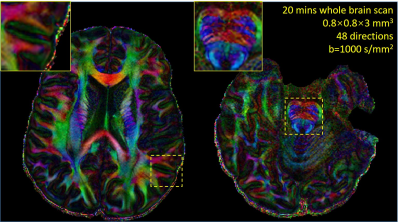 |
 Fast Distortion-Free Diffusion Imaging using “tilted-CAIPI” PSF-EPI Fast Distortion-Free Diffusion Imaging using “tilted-CAIPI” PSF-EPI
Zijing Dong, Fuyixue Wang, Timothy Reese, Mary Manhard, Berkin Bilgic, Lawrence Wald, Hua Guo, Kawin Setsompop
Single-shot EPI is widely used for diffusion imaging, but suffers from susceptibility-induced distortion and T2* blurring, which limit its resolution and ability to detect detailed structures. PSF-encoded EPI with an added 2D-navigator has recently been developed to allow distortion- and blurring- free diffusion imaging. However, the extremely long acquisition of PSF-EPI makes it impractical for high angular resolution diffusion imaging. In this work, PSF-EPI is accelerated by >20x using a novel “tilted-CAIPI” approach, along with self-navigation strategy. This has enabled distortion- and blurring-free diffusion imaging at 1.2mm isotropic to be acquired with 48 diffusion directions in 21-minutes for whole-brain.
|
16:18
 |
1205.
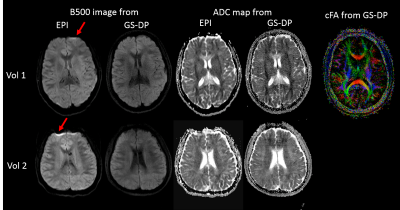 |
 Diffusion-prepared multi-shot bSSFP imaging with gradient stabilizer Diffusion-prepared multi-shot bSSFP imaging with gradient stabilizer
Yu Gao, Fei Han, Ziwu Zhou, Xingfeng Shao, Xiaodong Zhong, Danny Wang, Yingli Yang, Peng Hu
A gradient stabilizer strategy was proposed to solve the k-space magnitude inconsistency problem in multi-shot diffusion-prepared bSSFP imaging. Simulation studies showed that the proposed approach is insensitive to phase errors during the diffusion encoding stage, and has built-in fat-saturation property. Phantom and in-vivo studies verified that adding gradient stabilizers could remove signal loss and artifacts, and provide repeatable artifact-free images. Combined with existing phase correction techniques, the proposed approach provided distortion-free high-quality 2D diffusion-weighted and diffusion tensor images, and has the potential of extending to 3D.
|
16:30
 |
1206.
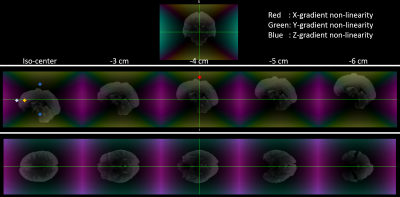 |
 Can we correct for interactions between subject motion and gradient-nonlinearity in diffusion MRI? Can we correct for interactions between subject motion and gradient-nonlinearity in diffusion MRI?
Suryanarayana Umesh Rudrapatna, Greg Parker, Jamie Roberts, Derek Jones
Scanners with ultra-strong gradients promise unprecedented opportunities for diffusion imaging. However, their effective use requires correction of gradient-nonlinearity effects during data analysis. Although such techniques exist, they neglect the effects of motion which induces spatio-temporal variations in b-values and b-vectors. Here, we propose a technique that accounts for interaction of subject motion with such non-linearity and study its effectiveness by performing diffusion experiments with volunteers positioned in regions with incrementally increasing gradient-nonlinearities. Our experiments reveal the importance of accounting for motion-induced spatio-temporal variations in B-matrices and our proposed technique corrects most gradient-nonlinearity effects.
|
16:42
 |
1207.
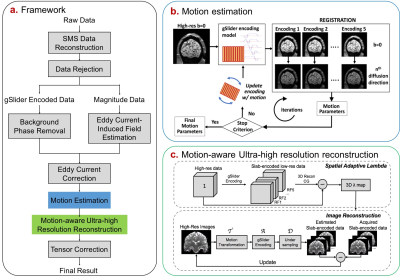 |
 Motion-robust sub-millimeter isotropic diffusion imaging through Motion Corrected Generalized Slice Dithered Enhanced Resolution (MC-gSlider) acquisition Motion-robust sub-millimeter isotropic diffusion imaging through Motion Corrected Generalized Slice Dithered Enhanced Resolution (MC-gSlider) acquisition
Fuyixue Wang, Berkin Bilgic, Zijing Dong, Mary Manhard, Ned Ohringer, Bo Zhao, Melissa Haskell, Stephen Cauley, Qiuyun Fan, Thomas Witzel, Elfar Adalsteinsson, Lawrence Wald, Kawin Setsompop
gSlider is an SNR-efficient acquisition technique for high-resolution diffusion imaging (dMRI). However, subject motion is inevitable during long scans in high-resolution dMRI, leading to potential for artifacts and blurring. In this study, Motion Corrected gSlider (MC-gSlider) is proposed to obtain high-quality dMRI in the presence of large in-plane and through-plane motion, without use of a navigator. A motion-aware reconstruction with spatially-adaptive regularization is developed to achieve good reconstruction, even under difficult through-plane motions. MC-gSlider was demonstrated in-vivo to provide motion-robust, sub-millimeter isotropic dMRI with a motion correction rate of 2s, allowing for good reconstruction in the presence of large motions.
|
16:54
|
1208.
 |
 Higher order spherical harmonics reconstruction of fetal diffusion MRI with intensity correction Higher order spherical harmonics reconstruction of fetal diffusion MRI with intensity correction
Maria Deprez, Anthony Price, Daan Christiaens, Donald Tournier, Mary Rutherford, Serena Counsell, Jo Hajnal
We present a comprehensive method for reconstruction of fetal dMRI signal using a higher order spherical harmonics representation. We show that intensity correction improves the consistency of the volumetric reconstruction. By applying constrained spherical deconvolution and whole brain tractography to reconstructed fetal dMRI we are able to identify anatomically plausible fiber crossings.
|
17:06
|
1209.
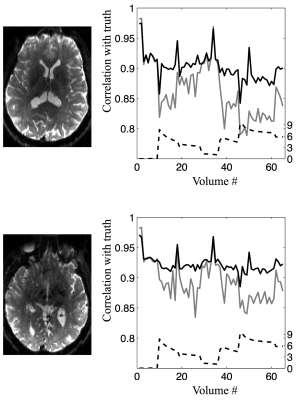 |
 Estimating susceptibility-induced field changes directly from diffusion MRI images and overcoming associated computational bottlenecks through GPU parallelisation Estimating susceptibility-induced field changes directly from diffusion MRI images and overcoming associated computational bottlenecks through GPU parallelisation
Frederik Lange, Mark Graham, Ivana Drobnjak, Hui Zhang, Jon Campbell, Jesper Andersson
We present a novel method (incorporated into FSL $$$\texttt{eddy}$$$) of estimating and correcting distortions due to dynamic changes in the susceptibility field when measuring diffusion using EPI. This method is able to track how the field changes with movement using only the diffusion data itself. We demonstrate an improvement in distortion correction, compared to using a static susceptibility field, for both simulated and actual data. Additionally, we demonstrate how computationally intensive portions of the estimation algorithm can be speeded up through GPU parallelisation. Reducing the runtime increases the likelihood of this method being widely adopted and broadens its impact potential.
|
17:18
|
1210.
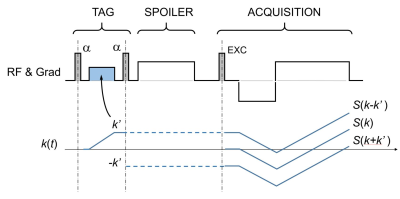 |
 In-Plane Superresolution with Phaseless Subpixel Encoding In-Plane Superresolution with Phaseless Subpixel Encoding
Franciszek Hennel, Rui Tian, Maria Engel, Klaas Pruessmann
A method to obtain a high-resolution 2D image from a series of subpixel-encoded low-resolution 2D scans is presented. The phaseless character of this encoding allows unknown signal phase fluctuations to be easily discarded and makes the method a promising alternative to k-space segmenting in motion-sensitive experiments such as diffusion MRI. Based on an analogy with the structured illumination method used in superresolution optics, important improvements have been introduced that reduce artefacts caused by k-space truncation and magnetic field inhomogeneity. The utility of the method is demonstrated by a 3-fold resolution enhancement of diffusion-weighted EPI of human head.
|
|













